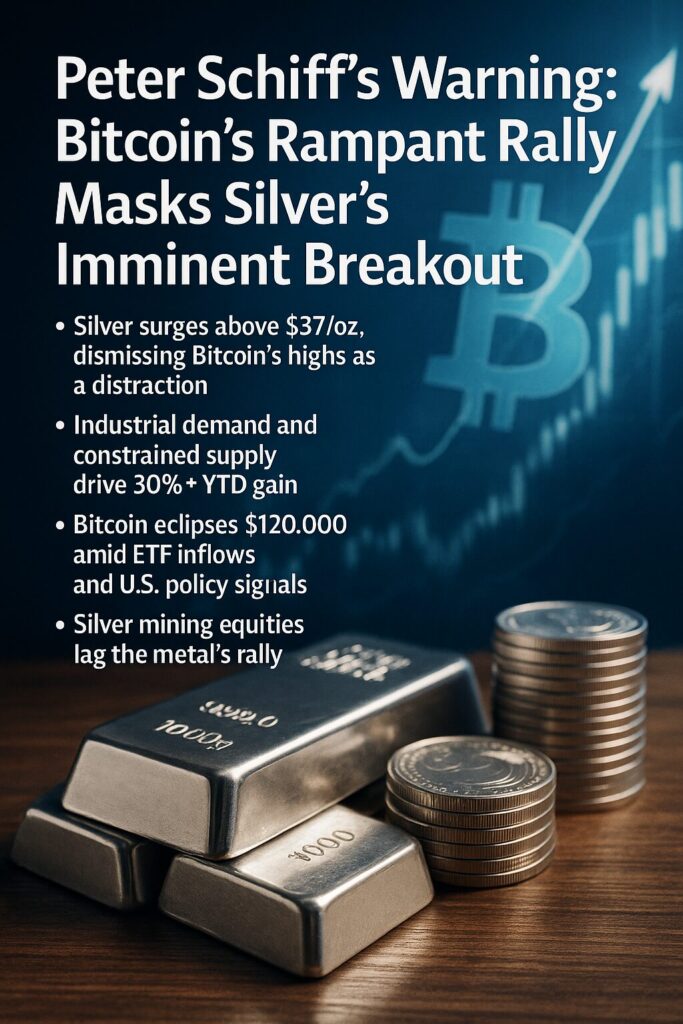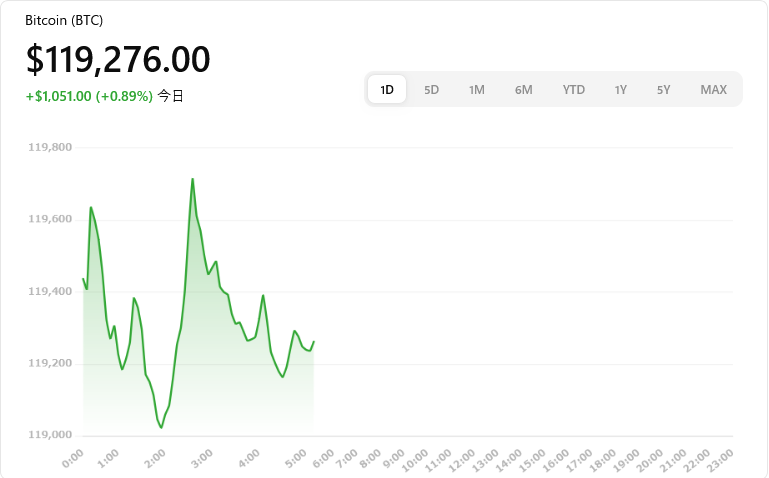
Main Points:
- Peter Schiff underscores silver’s surge above $37/oz, dismissing Bitcoin’s record highs as mere “distraction”
- Structural industrial demand and constrained supply underpin silver’s 30%+ YTD gain
- Bitcoin has eclipsed $120,000 amid ETF inflows and favorable U.S. policy signals
- Silver mining equities have lagged the metal’s rally, suggesting a delayed market recognition
- Investors face a crossroads: allocate between precious metals’ fundamental value and crypto’s structural momentum
1. Introduction
In mid‑July 2025, two seemingly divergent narratives have dominated financial headlines: Bitcoin’s breakthrough above $120,000 and silver’s ascent to multi‑year highs. While the crypto world celebrates another milestone in Bitcoin’s evolution, veteran gold‑and‑silver advocate Peter Schiff warns that this frenzy distracts investors from silver’s “true rally”. This article examines Schiff’s critique, unpacks the drivers behind silver’s surge, analyzes Bitcoin’s parabolic ascent, and explores strategic considerations for investors at this pivotal juncture.
2. Schiff’s Critique: Bitcoin vs. Silver
Peter Schiff, long a stalwart critic of cryptocurrencies, seized upon Bitcoin’s headline‑grabbing new all‑time highs to bolster his case for precious metals. On July 24, Schiff noted in an X post that silver exceeded $37/oz—up nearly 2% in a single day—while Bitcoin’s “nominal highs” represented nothing more than “distraction”. He reiterated that silver mining stocks have yet to reflect this price action in their equities, and he projected a swift advance toward $50/oz if silver clears its current resistance level. Schiff’s messaging underscores his conviction that investors are overlooking silver’s structural value, even as Bitcoin captures global attention.
3. The Dynamics Behind Silver’s Rally
Silver’s remarkable year‑to‑date gain—over 30%, the strongest in 14 years—stems from a confluence of elevated industrial demand and tightening supply. Key drivers include:
- Renewable Energy Growth: Photovoltaic solar deployment consumes significant silver, boosting industrial off‑take.
- Technological Applications: The metal’s conductivity remains indispensable in electronics, AI hardware, and defense systems.
- Supply Deficit: Global silver supply has dipped below demand levels, with annual production sliding from 1.06 billion ounces in 2016 to about 1.02 billion in 2024.
- Inflation Hedge: With central bank purchases of precious metals at multi‑year highs, silver benefits alongside gold, yet still trades cheap on a gold‑silver ratio basis.
These fundamentals suggest further upside potential once market attention shifts from crypto back to industrial‑metal drivers.
[Graph: Silver Price Trend January–July 2025]

4. Bitcoin’s Meteoric Ascent
Meanwhile, Bitcoin’s march to new all‑time highs has been fueled by sustained ETF inflows, accommodative U.S. regulatory signals, and broadening institutional adoption. Highlights include:
- ETF Inflows: Approval of multiple Bitcoin ETFs in 2024 unlocked billions in new capital.
- Policy Tailwinds: U.S. lawmakers have introduced industry‑friendly bills, dubbed “crypto week,” which propelled Bitcoin past $120,000 on July 14, 2025.
- Market Sentiment: A resilient macro backdrop—with hints of Fed rate cuts and a weakening dollar—has supported risk‑on assets, including Bitcoin and equities.
Despite Schiff’s derision, Bitcoin’s structural narrative as “peer‑to‑peer electronic cash” continues to resonate, driving price discovery to unprecedented levels.
[Graph: Bitcoin Price Trend January–July 2025]

5. Comparative Market Responses
Although both assets rally on monetary and macro uncertainties, market reactions diverge:
- Shell-Shocked Equities: Silver mining stocks and PM ETFs have underperformed, with many still failing to price in the metal’s recent highs.
- Crypto Volatility: Bitcoin’s 24‑hour swings often exceed 5%, reflecting speculative flows more than industrial or fundamental demand.
- Correlation Dynamics: Precious metals have shown an unusual positive correlation with equities and crypto, yet silver’s fundamental story remains distinct from digital assets.
This split in market responsiveness illustrates Schiff’s point: disparate investor mindsets drive asset prices, and complacency in one sector can mask opportunities in another.
6. Investor Implications
For portfolio architects, Schiff’s critique and the underlying data suggest a dual‑track approach:
- Diversification: Allocate to silver (via physical bullion, ETFs like SLV, or mining equities) to capture industrial‑metal upside.
- Selective Crypto Exposure: Maintain tactical positions in Bitcoin to leverage structural adoption and policy catalysts.
- Risk Management: Employ disciplined profit‑taking on both fronts; for silver, watch $38–$40 as near‑term resistance, and for Bitcoin, monitor consolidation around $120k–$130k.
- Thematic Overlay: Consider renewable energy and AI‑focused funds for silver demand, alongside blockchain infrastructure play for crypto.
Ultimately, blending the intrinsic value case for silver with Bitcoin’s disruptive potential may yield superior risk‑adjusted returns.
7. Conclusion
Peter Schiff’s admonition that Bitcoin’s rally is a “distraction” serves as a timely reminder: markets often overlook assets with deep industrial and monetary underpinnings. Silver’s supply‑demand imbalance and technological indispensability point to further gains, even as Bitcoin continues its structural conquest of the financial world. Savvy investors would do well to heed both narratives—capturing precious‑metal fundamentals while riding the crypto revolution, rather than choosing one to the exclusion of the other.

